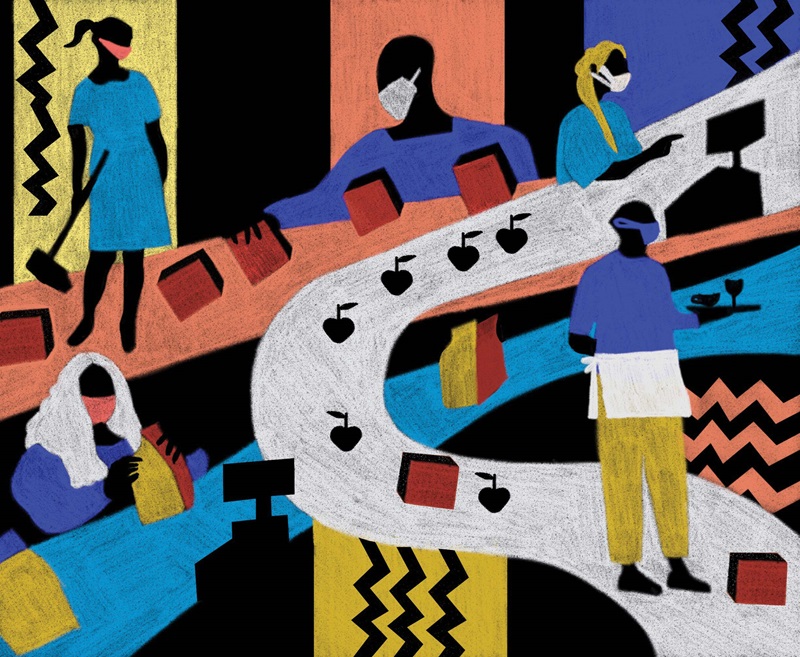How do workers vary in their exposure to both health and economic consequences of the COVID-19 pandemic? Answering that question involves understanding not only how sectors vary in their direct exposure to both types of disruption but also in their indirect exposure, through supply chains and demand linkages—the intricate network that constitutes the macroeconomy.

In our recent Institute working paper, we explore how worker exposure to health and economic risk varies across sectors and find that indirect exposure is a significant component of total risk.
We measure the health risk associated with maintaining essential goods and services during lockdowns and the economic risk associated with the shutdown of stores, restaurants, and other social-consumption establishments.
In brief, we find that:
- Health and economic risks cascade from essential sectors and social-consumption sectors into other sectors, through supply chains and demand linkages. In the United States, these cascading effects account for a quarter of total worker exposure to both types of risk.
- Cascading effects increase health risks for workers in the transportation and retail sectors, and increase economic risks for workers in the textile and petroleum sectors; in both cases, the cascading effects come mainly from demand linkages associated with retail.
- Relative to others, workers in education and construction are spared—facing lower health and economic risk.
Background
To slow the spread of the COVID-19 pandemic, governments have required social distancing measures that disrupt economic activity, depriving workers in many sectors of jobs and income. Some economic activities have been deemed essential, however, and workers in these sectors face higher health risk than others when countries go into lockdown, especially if their jobs cannot be done from home.
Among workers in non-essential sectors, those in sectors whose activity requires social contact with the public face direct and disproportionate economic risk because their jobs are soonest to close and slowest to return to normal activity levels. We term these “social-consumption” sectors.
Workers in still other sectors may experience disproportionate risk if their work is connected through supply chains and demand links to essential and social-consumption sectors. This study examines how worker exposure varies across all sectors—within and across, essential, social-consumption, and indirectly affected.
Directly affected sectors
Two groups of workers are particularly hard hit by the pandemic.
The first group works in sectors providing essential goods and services: health care, food and pharmaceutical products, communication services, and others. These workers face higher health risk than others because they continue working during lockdowns, which exposes them to greater risk of infection.
The second group are those working in establishments providing social consumption, such as hotels, restaurants, and much of retail. These workers face higher economic risk. Social consumption establishments are generally considered non-essential and are typically the first to be shut down and the last to reopen. Even after government-mandated closings are lifted, these establishments are likely to operate at low occupancy because customers will continue to avoid them until a vaccine or a treatment becomes available.
Indirect effects through supply chains and demand links
Workers employed in essential and social-consumption sectors are not the only ones who are disproportionately affected. People working for suppliers of these sectors, and for suppliers of those suppliers, and so on, will also be affected by the pandemic’s health and economic impact, albeit indirectly. A complete picture of each sector’s exposure to economic and health risk must therefore take into account the links across sectors coming from supply chains.
Indirect effects stem not only from supply chains but also from final demand linkages caused by complementarities in household consumption. A key complementarity is that between retail trade and the purchase of manufactured goods. Someone shopping for shoes, for example, might normally buy them at a retail shop. But if such businesses are closed, the shoe factory will suffer. These types of linkages are relevant to fully evaluate the health risk as well: Maintaining household food consumption requires keeping open not only establishments in the food industry, but also stores, wholesalers, and shipping companies.
To measure these links, we use the value of each sector’s purchases from every other sector. For example, hospitals and other health care establishments purchase 26 percent of their intermediate inputs from the “material and equipment” and “other professional services” sectors. We also use data on the retail, wholesale, and transportation services involved when households purchase manufacturing products. For each dollar of final product purchased, an additional 60 cents is paid on retail, wholesale, and transportation services combined.
Measuring risk
Arriving at estimates of differential exposure to health and economic risk that accounts for both direct and indirect effects requires modeling the supply and demand links across sectors, as well as detailed data on those links. Details of the methodology are covered in the working paper.
In brief, we use a standard input-output framework, augmented to account for demand linkages, which we calibrate on data from an international database, the World Input-Output Database. We compute measures for 43 countries, but in this brief discuss only the U.S. results.
Our measure of health risk is the proportion of each sector’s employment before the pandemic that is still needed at the workplace to meet demand for essential goods and services during the pandemic. Workers who can continue to work in the relative safety of their homes are deemed not at heightened risk. Our economic-risk measure is the proportion of each sector’s employment no longer needed after the household demand for social-consumption services drops by 90 percent. We assume that retail of agricultural, food, and chemical products is not affected by this shock. (The chemical product industry includes pharmaceutical products and cleaning supplies.) We focus on the effect of a drop in household demand and therefore set investment and exports to their prepandemic levels.
These simple measures neglect many important aspects of risk (see working paper), but nonetheless reveal a very stark picture of the disparity in exposure to both types of risk, as well as the importance of including indirect effects.
Health risk exposure
We estimate that 29 percent of U.S. workers are disproportionately exposed to health risk during the pandemic. About a quarter of these workers are working in non-essential sectors.
Sector-by-sector, health care workers account for 9.1 percent of the overall health risk, closely followed by public service employees (8.7 percent) and by workers in indirectly exposed sectors (7.7 percent). See Table 1.
| Total | Indirect | Agric. | Food | Chemical | Utilities | Telecom | Finance | Public admin. | Healthcare |
|---|---|---|---|---|---|---|---|---|---|
| 28.9 | 7.7 | 1.1 | 0.7 | 0.3 | 0.3 | 0.2 | 0.7 | 8.7 | 9.1 |
A closer look at each sector’s risk level (Figure 1) shows that, as expected, health risk is highest in three sectors providing essential goods and services: agriculture, health care, and food. Exposure in other essential sectors such as chemicals and public administration is lower, but still high (above 40 percent). Essential sectors such as postal and telecommunication, and finance, experience a 20 percent risk. These sectors face a low risk despite being essential because a large proportion of their workers can work from home.
Figure 1 also shows the cascade effects from supply chains and demand linkages. Workers in non-essential sectors (light blue) face health risk because providing essential goods and services (dark blue) requires production in these non-essential sectors as well. The most-exposed non-essential sectors are retail, auxiliary transportation, and inland transportation. Two of these three sectors—retail and inland transportation—are linked with essential sectors through demand complementarities. Least-exposed sectors are education, machinery, and material and equipment.
Economic risk exposure
We estimate that 21 percent of U.S. workers are disproportionately exposed to the economic risk caused by the collapse in household demand for social consumption. Here as well, indirect effects are substantial—more than a quarter of these workers are in sectors not directly impacted, but exposed through supply and demand linkages.
A sector-by-sector breakdown shows that 6 percentage points is due to the sectors linked to social-consumption sectors (Table 2). Workers in hotels and restaurants as well as retail account for the bulk of the total U.S. exposure to economic risk.
| Total | Indirect | Hotels & restaurants |
Inland transport |
Air transport |
Social & personal services |
Sales of motor vehicles |
Retail |
|---|---|---|---|---|---|---|---|
| 20.7 | 6.0 | 6.0 | 0.4 | 0.1 | 3.0 | 1.1 | 4.1 |
Turning to each sector’s exposure, we find that, as expected, economic risk is high in sectors directly affected by demand shock, such as hotels and restaurants, social and personal services, and air transportation (Figure 2).
Despite working in social-consumption sectors, workers in retail and inland transportation face substantially lower economic risk than hotel and restaurants workers (about 30-40 percent versus 70 percent). Retail services are only partially affected by demand shock since food and chemical retail is still open (about 40 percent of total retail) and some non-food retail shopping is done online (about 9 percent). Inland transportation is less affected because all these products continue to be shipped even as passenger transit is shut down.
The strongest cascade effects are felt by the textile and petroleum industries. Demand for these two sectors collapses because of demand links with retail. Demand links hence play a central role in the indirect exposure to the economic risk. The least affected sectors are health, public administration, construction, and education.
Conclusion
The data thus indicate that workers face disparate exposure to health and economic risks from the COVID-19 pandemic. While the greater part of this is felt directly—on essential and social-consumption sectors—a substantial portion is indirect, cascading to other sectors through supply chains and demand links. Policymakers and researchers hoping to fully understand the distributional consequences of alternative policies must therefore take into account both forms of risk, and indirect as well as direct exposure to those risks.






